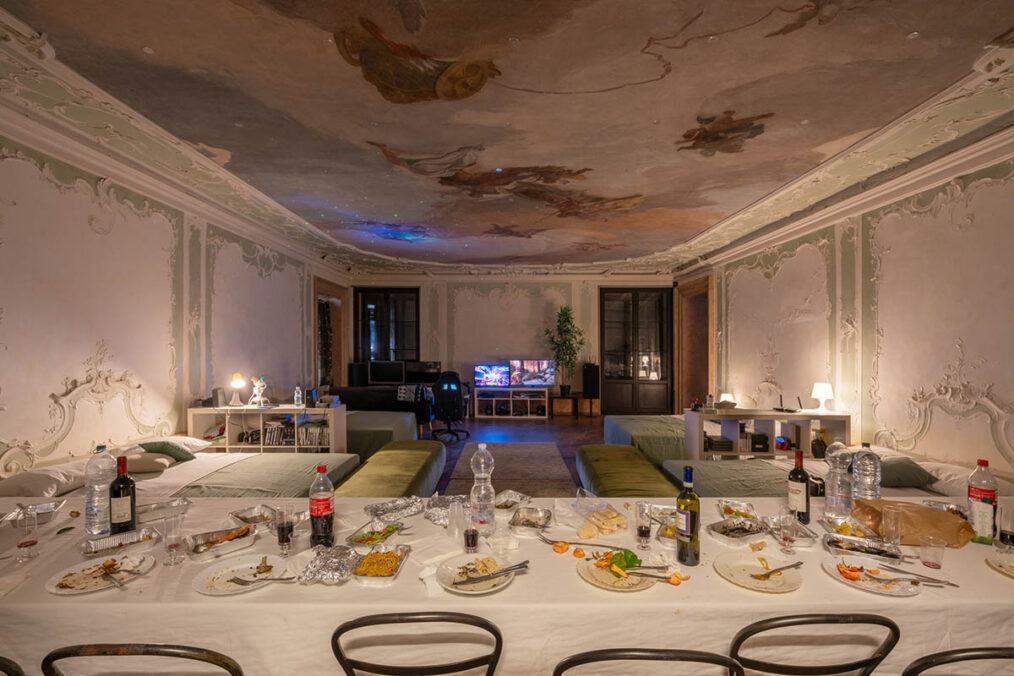
Originally the home of Venetian merchants Corner di San Cassiano, Ca’ Corner della Regina was built between 1724 and 1728 on the ruins of the Gothic palazzo in which Caterina Corner, the future Queen of Cyprus, was born in 1454. In 1800, the building became the property of Pope Pius VII, who assigned it to the charitable Congregation of the Padri Cavanis. From 1834 to 1969, it hosted the Monte di Pietà (Mount of Piety) of Venice, whereas, in 1975, it became the Historical Archive of the Venice Biennale and has been the Venice permanent space of Fondazione Prada since 2011.
The layered history of the building is Büchel’s framework for constructing an articulated network of spatial, economic, and cultural references. “Monte di Pietà” is a deep dive into the notion of debt as the root of human society and the primary vehicle by which political and cultural power is exercised. Historically, a crossroads of commercial and artistic exchange and intermingling, the city of Venice is an ideal context for exploring the relationships between these complex topics and the deep dynamics of contemporary society.

Installation view of “Monte di Pietà”. A project by Christoph Büchel, Fondazione Prada,Venice. Photo: Marco Cappelletti. Courtesy: Fondazione Prada 
Installation view of “Monte di Pietà”. A project by Christoph Büchel, Fondazione Prada,Venice. Photo: Marco Cappelletti. Courtesy: Fondazione Prada 
Installation view of “Monte di Pietà”. A project by Christoph Büchel, Fondazione Prada,Venice. Photo: Marco Cappelletti. Courtesy: Fondazione Prada
The project develops in an immersive environment, taking over the palazzo, specifically its ground floor, mezzanine, and first floor. It consists of a fictitious bankrupt pawnshop based on the original layout of the Monte di Pietà of Venice. Christoph Büchel’s work The Diamond Maker(2020-), a suitcase containing lab-grown diamonds, is on view in this context. It results from a physical and symbolic process of destruction and transformation of the artist’s entire body of artworks in his possession, including the ones from his youth and childhood and those yet to be created. The diamonds have been realized by ALGORDANZAAG, a company founded in 2004 in Switzerland that produces memorial diamonds globally. “Monte di Pietà” incorporates new productions and references of installations previously conceived by Christoph Büchel, a heterogeneous selection of objects, documents, historical and contemporary artworks related to property history, credit and finance, the development of collections and archives, and the creation and meaning of real or artificial wealth.
“Monte di Pietà” also explored the blurred boundaries between the physical and virtual dimensions of our contemporaneity. Through the online activity of a granfluencer and the activation of a cryptocurrency, the project deals with the immateriality and volatility of financial transactions in the digital sphere that, in an almost alchemical process, burn wealth to produce new value. The speculative mechanisms typical of cryptocurrencies are bent in favor of people who were born or are residents of the Municipality of Venice.

Installation view of “Monte di Pietà”. A project by Christoph Büchel, Fondazione Prada,Venice. Photo: Marco Cappelletti. Courtesy: Fondazione Prada
This token, called Schei and promoted on TikTok by the granfluencer Regina de schei, aims to create new profit and distribute it to Venetian inhabitants.
Originating in 15th-century Italy, the Catholic institutions called Monte di Pietà gave the poor access to loans at reasonable interest rates. They used funds from charitable donors as capital and made loans to low-income people. Borrowers offered valuables as collateral, making the Monte di Pietà an organization on the borderline between a pawnshop and a bank. Each object was associated with a personal history, debt, and mutual credit, an interest rate and a sale price in case the debtor has not returned to pay the interest and credit in a given period. After several unsuccessful attempts between the 16th and 18th centuries, the Banco Pignoratizio Comunale (Municipal Foreclosure Bank) was established in Venice in 1806. In 1822, a local bank, the Cassa di Venezia, was created and opened to the public.

Installation view of “Monte di Pietà”. A project by Christoph Büchel, Fondazione Prada,Venice. Photo: Marco Cappelletti. Courtesy: Fondazione Prada
Associated with Banco Pignoratizio, it could finance through the collection of savings pledge lending operations. In 1834, the Institute was named Monte di Pietà of Venice and relocated to the prestigious venue of Ca’ Corner della Regina. In Western history, debt, virtual money, and the birth of currency are intrinsically linked to the management of power that enables expansion and accumulation. Debt has always played an essential role in social and political upheavals, and rulers have repeatedly implemented debt cancellations throughout history, often used to restore the previous social order. In particular, the Republic of Venice was a mercantil estate that contributed to the birth of modern debt-based financial markets and the legal recognition of intellectual property.

Installation view of “Monte di Pietà”. A project by Christoph Büchel, Fondazione Prada,Venice. Photo: Marco Cappelletti. Courtesy: Fondazione Prada
Debt is also closely related to the practices of storage and accumulation of tangible and intangible resources. The art system, specifically museum institutions, plays a significant role in preserving heritages and collections and assigning symbolic and economic value to goods and objects.
Exhibition: Christoph Büchel – Monte di Pietà
Exhibition duration: from 20 April to 24 November 2024
Address and contact:
Fondazione Prada
Calle Corner, 2215, 30135 Venezia
www.fondazioneprada.org





